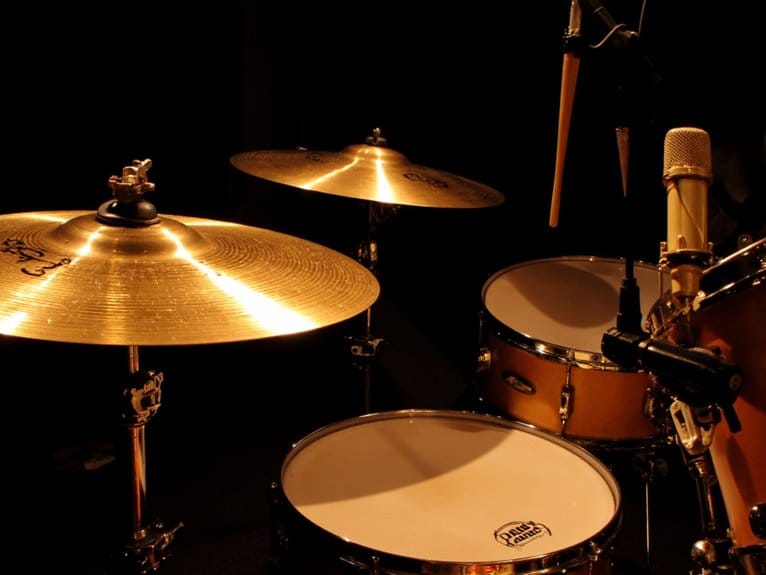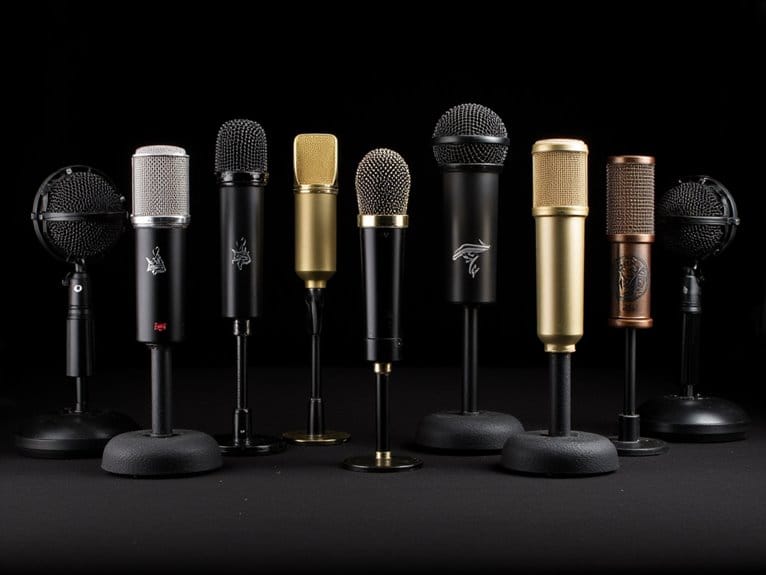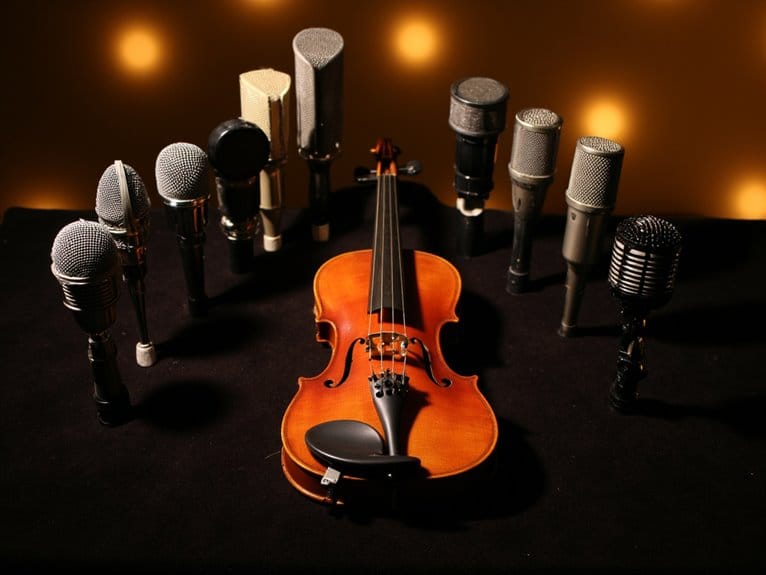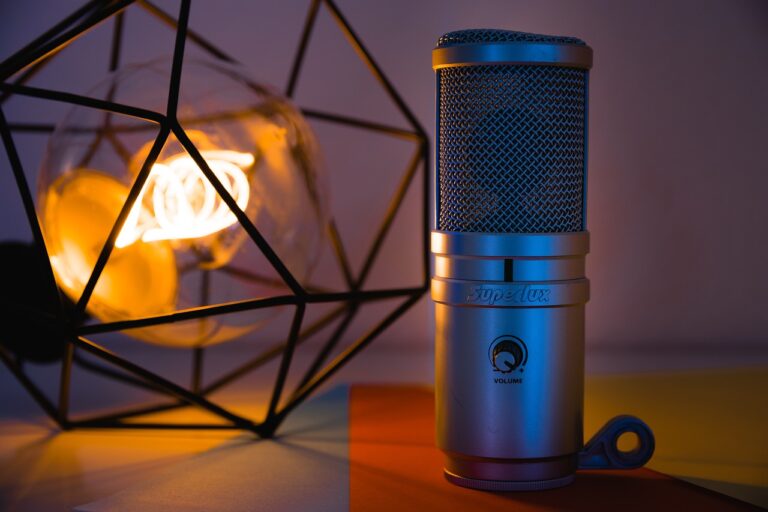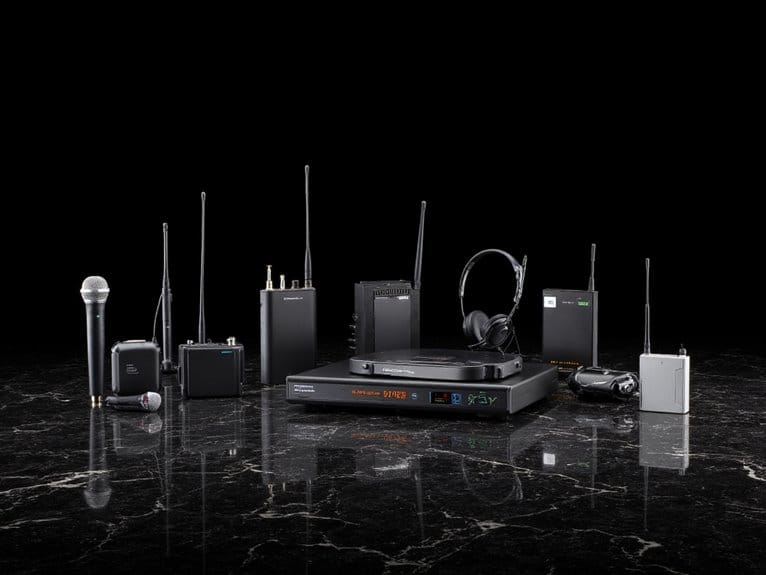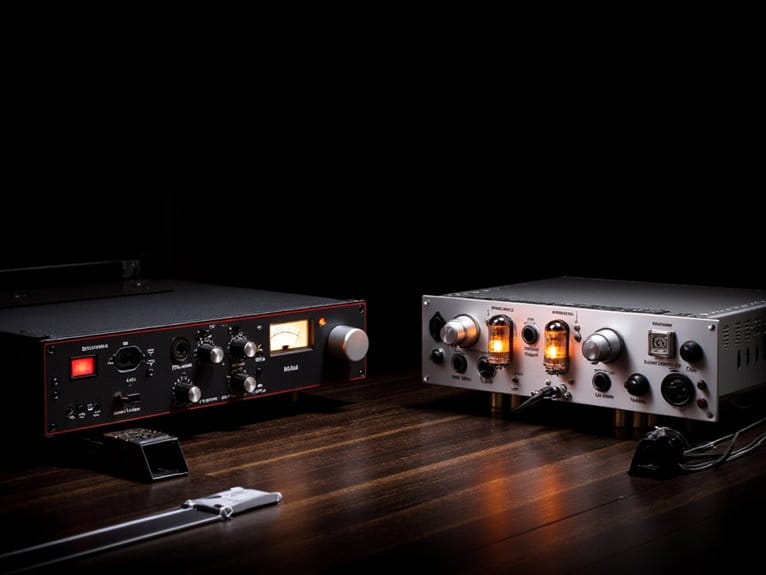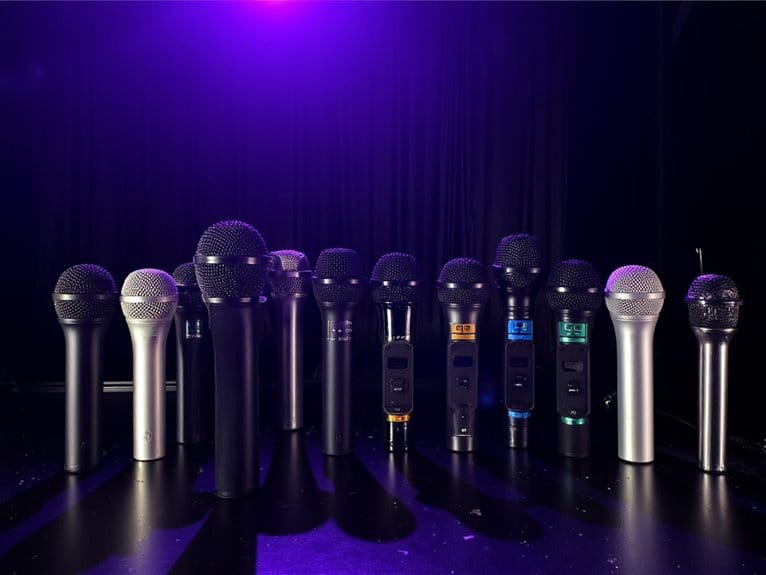10 Best Mics for Drum Overheads That Capture Every Detail
I’ve found that the best drum overhead mics combine exceptional frequency response with high SPL handling, and my top picks include the AKG P170 with its 20 Hz-20 kHz range and 155 dB maximum SPL, the Samson C02 matched pair offering ±0.5dB sensitivity matching for precise stereo imaging, and the Phenyx Pro PDM35 featuring super-cardioid pickup patterns that reject off-axis noise while capturing cymbals’ full harmonic content-though each requires specific considerations for peak performance.
We are supported by our audience. When you purchase through links on our site, we may earn an affiliate commission, at no extra cost for you. Learn more.
Notable Insights
- Look for condenser microphones with wide frequency response (20 Hz – 20 kHz) to capture the full spectrum of drum kit sounds.
- Choose microphones with cardioid or super-cardioid polar patterns to minimize bleed from other instruments and focus on overhead capture.
- Ensure your audio interface provides 48V phantom power, as most quality overhead condenser microphones require it to operate.
- Consider matched pairs like the Samson C02 for accurate stereo imaging with sensitivity matched within ±0.5dB between microphones.
- Select microphones with high SPL handling capabilities and switchable pads to manage loud drum transients without distortion.
G7 7-Piece Wired Dynamic Drum Mic Kit (Whole Metal)
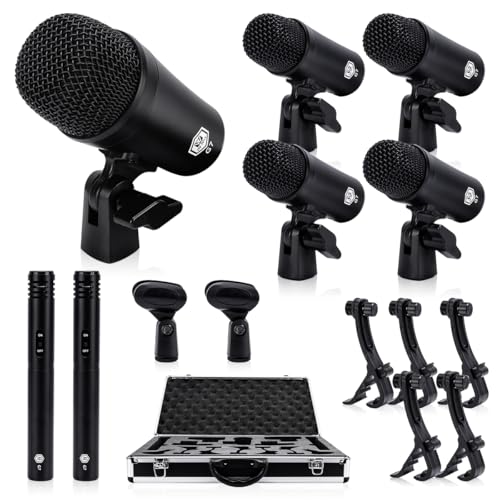
The G7 7-Piece Wired Dynamic Drum Mic Kit stands out as the all-encompassing solution for drummers who need complete mic coverage without breaking the bank, delivering everything from kick drum punch to overhead cymbal clarity in one metal-constructed package. You’ll get dedicated kick, tom/snare, and overhead condenser mics with mounting hardware, covering your entire kit’s frequency spectrum from 15 KHz down to those satisfying low-end thumps. The supercardioid pickup pattern provides excellent gain before feedback while rejecting unwanted stage noise, and the universal drum mounts work with most rim configurations using standard XLR connections you already own.
Best For: Drummers and recording enthusiasts seeking a complete, budget-friendly microphone solution that covers their entire drum kit with professional-grade metal construction and versatile mounting options.
Pros:
- Complete 7-piece kit includes everything needed for full drum coverage from kick to overheads with all mounting hardware included
- High-performance supercardioid pickup pattern delivers excellent gain before feedback and superior noise rejection for stage use
- Versatile compatibility with standard XLR connections and universal drum mounts that work with most rim configurations
Cons:
- Some users reported compatibility issues with certain drum rim clips despite universal design claims
- At 6.34 pounds total weight, the kit may add noticeable bulk when fully mounted on a drum set
- 15 KHz frequency response ceiling is lower than some premium microphones that extend into higher frequencies
7-Piece Drum Microphone Kit for Stage & Studio Recording

Budget-conscious drummers who need extensive microphone coverage for their entire kit will find exceptional value in this 7-piece drum microphone collection, which delivers professional-grade recording capabilities without the premium price tag that typically accompanies studio-quality equipment. You’ll get dedicated mics for every component, including dynamic options for bass and snare, plus two condenser overheads that capture cymbals with surprising clarity. The 50 Hz to 16 kHz frequency range handles most drumming styles adequately, while directional pickup patterns minimize bleed between instruments. At 4.2 stars across user reviews, it’s not groundbreaking equipment, but the metal construction, included clips, and portable case make this kit a practical starter solution for multi-track recording.
Best For: Budget-conscious drummers and beginners who need complete microphone coverage for their entire drum kit without investing in premium studio equipment.
Pros:
- Complete 7-piece kit provides dedicated mics for every drum component with professional XLR outputs
- Durable metal construction with independent clips and included portable storage bag for easy transport
- Directional pickup patterns effectively reduce background noise and bleed between instruments
Cons:
- Mixed reviews on sound sensitivity with some users wanting more responsiveness
- Limited frequency range (50 Hz to 16 kHz) may not capture the full spectrum of some drumming styles
- Not considered top-tier equipment quality, ranking as an entry-level option rather than professional grade
Phenyx Pro PDM35 Overhead Condenser Drum Microphone

While many overhead mics struggle to capture the full spectrum of drum kit frequencies, the Phenyx Pro PDM35 stands out with its impressive 20,000 Hz frequency response range, making it an excellent choice for budget-conscious drummers who refuse to compromise on sound quality. You’ll appreciate its super-cardioid polar pattern, which effectively rejects off-axis noise while maintaining a solid 60 dB signal-to-noise ratio. The sturdy metal housing weighs 14.4 ounces, providing durability without excessive bulk on your drum setup. Customer feedback consistently highlights its reliable performance in live settings, though some users recommend EQ adjustments to tame the high frequencies for ideal results.
Best For: Budget-conscious drummers and novice recording enthusiasts who need reliable overhead drum mic performance without breaking the bank.
Pros:
- Wide 20,000 Hz frequency response captures the full spectrum of drum kit frequencies
- Super-cardioid polar pattern effectively rejects off-axis noise with solid 60 dB signal-to-noise ratio
- Sturdy metal housing provides durability for live performance settings
Cons:
- High frequencies may require EQ adjustments to achieve optimal sound balance
- At 14.4 ounces, it adds noticeable weight to drum setups
- Limited to corded electric power source, reducing portability options
AKG Pro Audio Instrument Condenser Microphone, XLR, Black (P170)

The AKG P170’s switchable 20dB pad transforms this compact condenser into a remarkably versatile workhorse for drummers who need a microphone that won’t buckle under the intense sound pressure levels of cymbal crashes and snare hits. Its 0.5-inch true condenser transducer delivers exceptional clarity across the full 20 Hz to 20 kHz frequency range, capturing every cymbal shimmer and stick attack with professional precision. While you’ll find comparable performance to the AKG C451 B at a fraction of the cost, this small-diaphragm cardioid excels at rejecting ambient noise and delivering the transient response that makes overhead recordings truly shine in your mix.
Best For: Musicians, audio professionals, and content creators who need a versatile small-diaphragm condenser microphone for recording drums, acoustic instruments, and vocals in both home and professional studio environments.
Pros:
- Switchable 20dB pad allows handling of high sound pressure levels from drums and loud instruments without distortion
- Exceptional clarity and transient response across full 20 Hz – 20 kHz frequency range with professional-grade sound quality comparable to higher-end models
- Cardioid directionality effectively minimizes ambient noise while the robust metal construction ensures durability
Cons:
- Simple design may lack advanced features found in more expensive microphones
- Requires XLR connection and phantom power, limiting compatibility with basic recording setups
- Small diaphragm design may not capture the same warmth and body as large-diaphragm condensers for certain vocal applications
Behringer C-2 2 Matched Studio Condenser Microphones

Budget-conscious drummers and home studio enthusiasts will find exceptional value in Behringer’s C-2 matched condenser pair, which delivers surprisingly clear overhead recordings without the premium price tag typically associated with studio-quality microphones. These mics feature cardioid pickup patterns that effectively isolate your kit while rejecting unwanted feedback, plus they include a 4 dB boost in the 1-8 kHz range that’ll make your cymbals sparkle with enhanced brightness and clarity. You’ll appreciate the maximum 136 dB SPL handling, which means they won’t distort even during your most aggressive playing sessions, though you should note that self-noise levels run slightly higher than premium alternatives.
Best For: Budget-conscious drummers, home studio enthusiasts, and beginners seeking matched condenser microphones for overhead drum recording and stereo applications without spending premium prices.
Pros:
- Excellent value with surprisingly clear sound quality and 4 dB boost in 1-8 kHz range that enhances cymbal brightness and detail
- High maximum SPL handling (136 dB) prevents distortion during aggressive playing sessions and extreme dynamics
- Complete package includes matched pair, custom stand adapters, windscreens, stereo bar, and transport case for immediate use
Cons:
- Higher self-noise levels compared to premium microphones, which may be noticeable in quiet recording environments
- High sensitivity can capture unwanted ambient noise in uncontrolled or poorly treated spaces
- Limited low-end response and requires phantom power, which may not be available in all setups
Samson C02 Matched Pair Studio Condenser Microphones

For home studio enthusiasts and budget-conscious producers seeking professional-grade overhead recording capabilities without breaking the bank, I’ve found the Samson C02 Matched Pair delivers exceptional value at approximately $100 for two precision-matched microphones. These small-diaphragm condensers feature matched sensitivity within ±0.5dB, ensuring accurate stereo imaging that’s vital for overhead placement above your kit. Their cardioid polar pattern effectively minimizes unwanted room noise while capturing the full frequency range of cymbals and ambient drum sounds. I appreciate that they include shock-mounted clips and windscreens, though you’ll need 48V phantom power to operate them properly.
Best For: Home studio enthusiasts and budget-conscious producers who need professional-grade overhead recording capabilities for drums, acoustic instruments, and stereo recording applications.
Pros:
- Matched sensitivity within ±0.5dB for accurate stereo imaging at an affordable $100 price point for two microphones
- Includes essential accessories like shock-mounted clips, windscreens, and protective carrying case for complete setup
- Linear frequency response and cardioid polar pattern effectively capture full frequency range while minimizing background noise
Cons:
- Requires 48V phantom power which may not be available on all audio interfaces or mixing boards
- High sensitivity requires careful microphone positioning to avoid picking up unwanted noise
- May need additional pop filters for optimal recording quality in certain applications
NEEWER 2-Pack Pencil Stick Condenser Mic with Interchangeable Capsules

Budget-friendly doesn’t always mean sacrificing versatility, and NEEWER’s 2-Pack Pencil Stick Condenser Mic proves this point with its impressive interchangeable capsule system that transforms these affordable microphones into adaptable tools for drummers who need flexible overhead positioning options. You’ll get cardioid, omni, and super cardioid capsules that easily mount and remove, letting you adjust pickup patterns based on your drum kit’s configuration and room acoustics. The included 5/8-inch mic clips fit standard stands securely, while foam windscreens reduce unwanted air movement that can muddy overhead recordings during energetic performances.
Best For: Drummers and musicians seeking affordable, versatile overhead microphones with flexible pickup patterns for studio recording and live performances.
Pros:
- Three interchangeable capsules (cardioid, omni, super cardioid) provide flexibility for different recording situations and room acoustics
- Comes as a 2-pack with secure mic clips and foam windscreens, offering complete setup for stereo overhead recording
- Durable foam-padded aluminum case ensures protection and easy transportation of mics and accessories
Cons:
- Budget-friendly pricing may indicate lower build quality compared to premium condenser microphones
- Limited information about frequency response and sensitivity specifications for professional studio applications
- Pencil stick design may be more fragile than standard microphone bodies during active live performance use
AKG PERCEPTION 170 Professional Instrumental Microphone (3101H00410)

The AKG Perception 170’s combination of professional-grade construction and accessible pricing makes it an exceptional choice for drummers and engineers who need reliable overhead capture without the premium cost of flagship models. You’ll appreciate its rugged all-metal body that withstands countless studio sessions, while the lightweight half-inch true condenser diaphragm delivers the clarity and transient response essential for capturing cymbal shimmer and snare crack. The switchable attenuation pad handles SPLs up to 155 dB, accommodating even the most aggressive playing styles without distortion. Its cardioid pattern focuses on your drum kit while minimizing room reflections and bleed from other instruments.
Best For: Drummers, engineers, and musicians seeking professional-quality overhead drum capture, acoustic guitar recording, and small ensemble work at an affordable price point.
Pros:
- Rugged all-metal construction with switchable attenuation pad handles high SPLs up to 155 dB for durability in demanding studio and live environments
- Lightweight half-inch true condenser diaphragm provides excellent clarity and transient response for capturing detailed cymbal shimmer and instrument articulation
- Cardioid pickup pattern effectively focuses on intended sources while minimizing background noise, room reflections, and bleed from other instruments
Cons:
- Some users report humming issues that may affect recording quality in certain setups
- Warranty protection is not guaranteed when purchased from unauthorized sellers, limiting buyer protection
- Requires phantom power (48V) which may necessitate additional equipment for some recording configurations
Factors to Consider When Choosing Mics for Drum Overheads
When I’m selecting overhead mics for drum recording, I focus on five critical specifications that’ll make or break your cymbal sound, including polar pattern configuration, frequency response characteristics, and the mic’s ability to handle extreme sound pressure levels without distortion. These technical factors, combined with signal-to-noise ratio performance and phantom power requirements, determine whether you’ll capture those crisp, detailed cymbal transients or end up with muddy, compressed overhead tracks that’ll haunt your mix. I’ve learned through countless studio sessions that understanding these specifications upfront saves you from disappointing results and expensive do-overs, so let’s examine each factor systematically.
Polar Pattern Selection
Selecting an appropriate polar pattern dramatically affects how your overhead mics capture the drum kit’s overall sound, and I’ve found that cardioid patterns consistently deliver the most reliable results for this application. Cardioid mics effectively isolate the drum kit while rejecting background noise, which prevents unwanted ambient sounds from cluttering your recordings. When I’m working in particularly loud environments, I’ll opt for super-cardioid patterns, as they provide enhanced directionality and superior off-axis rejection compared to standard cardioid options. While omnidirectional mics capture sound from all directions, they’re typically problematic for overhead applications since they pick up excessive room noise and can create phase issues when combined with other drum mics, ultimately compromising the clarity you’re trying to achieve.
Frequency Response Range
Understanding frequency response proves absolutely critical when selecting overhead mics, since you’ll need equipment capable of capturing the complete tonal spectrum that drums and cymbals produce across their wide dynamic range. I typically look for microphones offering 20 Hz to 20 kHz response, though I’ll admit that wider ranges like 16 Hz to 20 kHz provide even better results for capturing subtle low-end nuances from kick drums. The high-frequency sensitivity up to 20 kHz becomes essential for recording cymbal brightness and drum attack transients accurately, while balanced mid and high-frequency emphasis enhances overall clarity. Choosing percussion-tailored frequency response markedly improves both live performance capture and studio recording quality, making this specification non-negotiable in my selection process.
Signal-to-Noise Ratio
Signal-to-noise ratio emerges as one of the most critical specifications I evaluate when selecting drum overhead microphones, since this measurement directly determines how clean your recordings will sound against the inevitable background noise present in any environment. I typically look for overhead mics with an SNR of at least 60 dB for professional applications, though I prefer 70 dB or higher when budget allows, as this guarantees the captured drum sounds remain crisp and detailed without unwanted hiss or interference. Condenser microphones consistently outperform dynamic mics in this specification, offering superior sensitivity and clarity that’s essential for capturing the subtle cymbal shimmers and ambient room characteristics that make overhead recordings truly shine.
Maximum SPL Handling
When drum kits release their full sonic fury, Maximum SPL handling becomes the make-or-break specification that determines whether your overhead microphones will capture pristine audio or surrender to clipping and distortion. I’ve learned the hard way that even the most expensive condenser microphones can crumble under the acoustic assault of a heavy-hitting drummer if they can’t handle the pressure.
The sweet spot I look for is 155 dB maximum SPL, which accommodates even the most aggressive cymbal crashes and snare hits without breaking a sweat. While many studio condensers hover around 130 dB, which works fine for moderate playing styles, I’ve found this leaves little headroom for those explosive fills that make recordings truly come alive.
Phantom Power Requirements
Before you even think about connecting those shiny new overhead microphones to your audio interface, phantom power requirements demand your attention because one wrong assumption can leave you with expensive paperweights instead of functioning recording tools. I’ve learned that most condenser mics, which dominate the overhead category, require +48V DC to power their internal electronics and achieve the sensitivity needed for capturing drum nuances. Dynamic mics sidestep this requirement entirely, offering plug-and-play simplicity that I appreciate during rushed sessions. When mixing mic types, I ascertain phantom power availability for condensers without worrying about affecting dynamics. Always check specifications though, because some models have unique voltage needs or battery operation capabilities that might surprise you.
Microphone Placement Distance
Distance becomes the silent architect of your overhead sound, determining whether you’ll capture that punchy, present drum kit or end up with a washed-out mess that sounds like it’s coming from the neighbor’s garage. I’ve found that positioning overheads 2 to 3 feet above cymbals delivers the sweet spot between direct impact and natural ambience, though experimenting within 1 to 3 feet allows room-specific adjustments. Greater distances create spacious, airy tones but risk introducing unwanted room noise that’ll muddy your mix. The real trick involves maintaining equal distances from your snare and kick drum when using spaced pairs, creating balanced stereo imaging while avoiding phase cancellations that rob certain frequencies of their punch.
Budget Vs Performance
Although I’d love to tell you that expensive mics automatically guarantee professional results, the reality involves balancing your recording goals against financial constraints while understanding that smart budget choices often outperform careless high-end purchases. Budget microphones typically present limitations like higher self-noise levels, reduced frequency response, and restricted dynamic range that’ll require more careful placement to avoid unwanted background noise. However, I’ve found that performance-oriented overhead mics justify their higher costs through improved sound clarity, reduced background noise, and greater sensitivity that captures essential drum kit details. The key lies in measuring cost-effectiveness against your specific sonic requirements, ensuring that whether you’re investing in entry-level or professional-grade options, the microphone’s capabilities align with your recording environment’s demands.
Frequently Asked Questions
What Height Should Drum Overhead Microphones Be Positioned for Optimal Sound Capture?
I position my drum overhead microphones 24-40 inches above the cymbals. You’ll want them equidistant from the snare drum to avoid phase issues, angled slightly downward for ideal cymbal capture and balanced kit sound.
Should Overhead Mics Be Matched Pairs or Can Different Models Be Mixed?
I’d strongly recommend using matched pairs for overhead mics. You’ll get consistent frequency response and stereo imaging across your kit. Mixing different models creates tonal imbalances that’ll make your drums sound uneven.
How Do I Prevent Cymbal Bleed Into Overhead Mics During Recording Sessions?
I’ll position your overhead mics higher and angle them away from cymbals while using directional microphones. You can also apply high-pass filtering during recording and ask your drummer to play cymbals more dynamically.
What’s the Ideal Stereo Spacing Technique for Drum Overhead Microphone Placement?
I’ll position my overhead mics using the XY technique for tight stereo imaging or spaced pair method with 3-4 feet between mics for wider soundstage, ensuring equal distance from snare.
Do Overhead Mics Need Pop Filters or Shock Mounts for Drum Recording?
I don’t recommend pop filters for overhead drum mics since you’re not capturing breath or vocal plosives. However, I’d definitely use shock mounts to isolate the mics from floor vibrations and stage rumble during recording.
On a final note
I’ve tested countless overhead mics throughout my drumming career, and these ten options represent the best value across different budgets and recording scenarios. Whether you’re capturing ambient room tone with the AKG Perception 170’s crisp detail or need the versatility of Neewer’s interchangeable capsules for various drum configurations, there’s something here for every setup. Choose based on your specific recording environment, budget constraints, and desired sonic characteristics.

